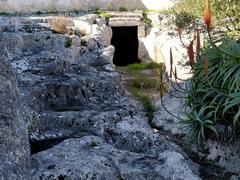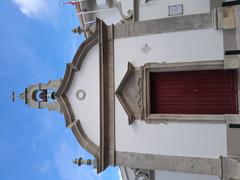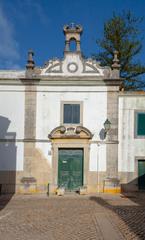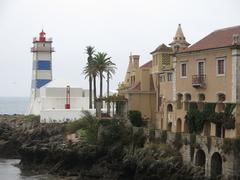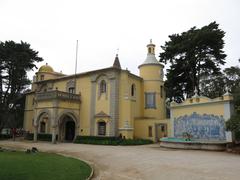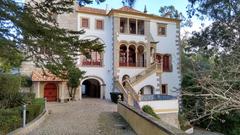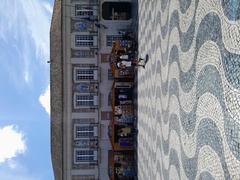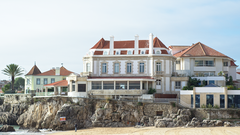Ponte Filipina Sobre a Ribeira de Caparide: Visiting Hours, Tickets, and Comprehensive Guide
Date: 14/06/2025
Introduction
Nestled in the scenic Estoril region, within the municipality of Cascais, Portugal, the Ponte Filipina Sobre a Ribeira de Caparide stands as a remarkable testament to early 17th-century Portuguese civil engineering. Built in 1604 during the reign of King Filipe II, the bridge is a living symbol of the Portuguese Filipina period (1580–1640), reflecting both the era’s technical innovations and its cultural legacy. Once a critical crossing supporting trade, defense, and communication along the Estoril coast, the bridge today is preserved as a cherished municipal monument, offering visitors a tranquil setting to experience history and nature side by side (Monumentos SIPA; Cultura Cascais).
This detailed guide provides an in-depth look at the Ponte Filipina’s architectural features, historical significance, environment, and practical information for visitors, including hours, tickets, accessibility, and nearby attractions. Whether you are a history enthusiast, nature lover, or exploring the Lisbon coast, this article equips you with everything you need for a rewarding visit.
Contents
- Introduction
- Historical Background and Architectural Features
- Cultural and Regional Significance
- Integration with Natural and Urban Landscape
- Visiting Information (Hours, Tickets, Accessibility)
- Getting There
- Nearby Attractions
- Environmental and Natural Context
- Visitor Experience & Responsible Tourism
- Climate and Seasonal Tips
- Relationship to Broader Ecological Networks
- Frequently Asked Questions (FAQ)
- Conclusion & Visit Tips
- Sources and Further Reading
Historical Background and Architectural Features
Construction and Design
Commissioned in 1604 under King Filipe II, the Ponte Filipina Sobre a Ribeira de Caparide is the oldest surviving bridge in Cascais municipality. The bridge was financed by a municipal tax and constructed by João Jorge Morgado for 76,000 reais—a substantial investment reflecting its regional importance (cultura.cascais.pt). Built primarily from local limestone and granite, the bridge features two semicircular arches (abóbadas de volta perfeita) and angular cutwaters at its base to deflect water and prevent erosion, showcasing advanced engineering for its time (vaiver.com).
Structural Details
- Materials: Local limestone and granite
- Arches: Two semicircular spans with cutwaters
- Dimensions: Estimated length of 10–15 meters, wide enough for historical carts and pedestrians
- Design Features: Low parapets, durable masonry, and cutwaters for hydraulic resilience (Monumentos SIPA)
Conservation
After decades of partial neglect and overgrowth, significant restoration efforts in 2022–2023 stabilized the bridge, cleared invasive vegetation, and improved its visibility. It remains closed to direct pedestrian and vehicular crossing to protect its structure, but is fully accessible for observation and photography from nearby vantage points (vaiver.com).
Cultural and Regional Significance
Historical Role
The bridge played a vital role in regional development, serving as a strategic crossing in the military and economic network linking Lisbon to Cascais and its coastal fortifications (maxcidadela.com). It enabled the movement of people, goods, and troops, supporting the formation and growth of nearby settlements like São Pedro do Estoril, Caparide, and Matarraque.
Heritage Status and Community Value
The Ponte Filipina is designated a Monument of Municipal Interest since 2008 and is a focal point for local heritage education and cultural initiatives. Its preservation reflects community pride and a commitment to maintaining historic and environmental assets for future generations (cultura.cascais.pt).
Integration with Natural and Urban Landscape
Geographic Setting
Located over the Ribeira de Caparide, the bridge sits within a semi-rural valley characterized by Mediterranean vegetation, native cork oaks, and stone pines. The Ribeira de Caparide originates in the Sintra hills before reaching the Atlantic at São Pedro do Estoril, creating a lush riparian corridor (Cascais Municipality).
Urbanization and Conservation
Urban growth in the 20th century introduced new pressures—such as pollution and flood risk—but also inadvertently protected the bridge by diverting heavy traffic elsewhere. Ongoing conservation efforts balance heritage protection with ecological restoration in the face of urban expansion (Wikipedia: Ribeira de Caparide).
Visiting Information
Hours and Tickets
- Opening Hours: Open-air site accessible year-round during daylight (sunrise to sunset)
- Tickets: Free entry; no tickets required
- Safety: The bridge itself is closed to crossing—please view from designated trails and vantage points
Accessibility
Paths to the bridge vary from paved to unpaved and may be uneven. While generally accessible to most visitors, those with mobility impairments may find access challenging. Comfortable, sturdy footwear is recommended.
Getting There
- By Train: Take the Lisbon-Cascais suburban line to São Pedro do Estoril station; the bridge is a 5-minute walk.
- By Car: Limited parking is available near São Pedro do Estoril beach and station; public transport is recommended during peak times.
- Navigation: GPS or smartphone map applications are advised as signage is minimal (Cascais Tourism Official Website).
Nearby Attractions
- Grutas Artificiais de São Pedro do Estoril: Prehistoric caves with archaeological significance (maxcidadela.com).
- Praia de São Pedro do Estoril: A popular beach for surfing and relaxation.
- Centro de Interpretação Ambiental Pedra do Sal: Environmental center with interactive exhibits (ambiente.cascais.pt).
- Estoril and Cascais Town Centers: Featuring museums, gardens, and the famous Casino Estoril (cascaisportugaltourism.com).
- Sintra-Cascais Natural Park: Extensive nature trails and biodiversity (ICNF).
Environmental and Natural Context
Hydrology and Flora & Fauna
The Ribeira de Caparide is a seasonal stream with higher flows in winter and spring. The valley supports riparian vegetation—willows, alders, reeds—while surrounding hills feature Mediterranean maquis. Wildlife includes kingfishers, blackbirds, amphibians, and reptiles like the ocellated lizard (ICNF).
Conservation Efforts
Municipal and NGO initiatives focus on water quality, habitat restoration, and environmental education. The bridge is protected by municipal laws, contributing to broader regional ecological networks and biodiversity corridors (Cascais Ambiente).
Visitor Experience & Responsible Tourism
- Activities: Enjoy walking, birdwatching, and photography—especially in spring and autumn.
- Responsible Practices: Stay on marked trails, avoid disturbing wildlife, carry out litter, and respect heritage signage.
Information panels along nearby trails enhance the educational value of your visit (Cascais Ambiente).
Climate and Seasonal Tips
- Spring (March–May): Flowing rivers, wildflowers, ideal for visits.
- Summer (June–September): Warm and dry; visit early or late in the day.
- Autumn (October–November): Pleasant weather, refreshed landscape.
- Winter (December–February): Higher water, be mindful of muddy trails.
Check forecasts and dress for outdoor conditions (IPMA).
Relationship to Broader Ecological Networks
The bridge and valley are part of ecological corridors linking Sintra-Cascais Natural Park to the Atlantic, supporting wildlife movement and biodiversity. Conservation of both the structure and its setting exemplifies the integration of cultural and natural heritage (ICNF).
Frequently Asked Questions (FAQ)
Q: Is there an entrance fee to visit Ponte Filipina Sobre a Ribeira de Caparide?
A: No, access is free year-round.
Q: Are guided tours available?
A: Occasionally, local heritage walks and tours include the bridge; check with Cascais Tourism.
Q: Is the site accessible for those with mobility impairments?
A: Access may be limited due to uneven terrain.
Q: What is the best time to visit?
A: Spring and autumn are recommended for pleasant weather and scenic views.
Q: Are there facilities nearby?
A: Amenities are available in Estoril and Cascais town centers.
Conclusion & Visit Tips
The Ponte Filipina Sobre a Ribeira de Caparide offers a unique blend of historical intrigue, architectural heritage, and natural beauty. As the oldest bridge in Cascais, it stands as a testament to the region’s strategic past and enduring resilience. Free to access and easily reached by public transport, the site is perfect for history buffs, photographers, and nature enthusiasts alike.
Enhance your experience by exploring nearby attractions, participating in responsible tourism, and engaging with local conservation efforts. Share your visit using #PonteFilipinaEstoril to join the heritage community and help preserve this landmark for future generations.
Plan your visit today, and for more insights on Cascais and Estoril, consult the resources below or download the Audiala app for personalized recommendations.
Sources and Further Reading
- Visiting Ponte Filipina Sobre A Ribeira De Caparide: History, Tickets & Travel Tips, 2025, Audiala Website (https://www.audiala.com/ponte-filipina-estoril)
- Visiting Ponte Filipina in Cascais: History, Hours, Tickets, and Travel Tips, 2025, Cascais Heritage Guide (http://www.monumentos.gov.pt/Site/APP_PagesUser/SIPA.aspx?id=34597)
- Ponte Filipina Visiting Hours, Tickets & Guide to Cascais Historical Sites, 2025, Vaiver Tourism Portal (https://www.vaiver.com/lisboa/estoril-ponte-filipina-de-sao-pedro-do-estoril/)
- Visiting Ponte Filipina Sobre a Ribeira de Caparide: Hours, Tickets, and Nearby Attractions in Estoril, 2025, Cascais Municipality and Environmental Agency (https://www.cascais.pt/)
- Institute for Nature Conservation and Forests (ICNF), 2025 (https://www.icnf.pt/)
- Cascais Tourism Official Website, 2025 (https://www.visitcascais.com/)
- Portuguese Weather Institute (IPMA), 2025 (https://www.ipma.pt/)
